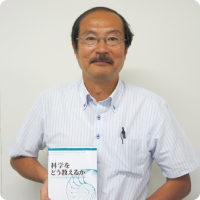- Notice
The "?" generated by the discussion was turned into a "! to "!" in physics experiments using ICT. to "!
2013.12.10
Toshiaki Yamazaki, Doshisha Junior & Senior High School
In 2009, he conducted a survey of 3,800 first-year university students in the science field and found that 20% of all high school physics students in Japan do not conduct experiments, and 60% conduct experiments less than five times. Currently, he is developing and disseminating a lesson plan that everyone can practice with a small budget, which he believes is necessary.

Physics Education Abroad with Teams
In 2001, Mr. Yamazaki felt that "experiments" were a particular issue in physics classes, and together with teachers in Kyoto and Wakayama, he established a study group for "Advanced Physics," a new type of physics course introduced in the U.K. that focuses on experiments and other inquiry-based activities. The thick teaching materials were carefully examined by high school teachers and about 30 members, including university faculty members, who continued to verify the lessons through open lectures. The most valuable thing about this team may be that it has formed a regional, private-public, and high school-university partnership among physics teachers, who are becoming increasingly isolated and decreasing in number." said Mr. Kato.
Before the experiment, "I want to be sure!" before an experiment.
At the 2006 International Conference on Physics Education, we were attracted by a report that "active learning significantly enhances understanding of physics concepts," which has been developed in the United States in recent years, and began a new study at the Advancing Physics Research Group. As a result, in 2011, we were able to demonstrate a remarkable effect in a class on "acceleration," which is considered to be difficult to establish concepts.
After conveying the basic concepts of velocity and acceleration, the class was given the theme "Predict the velocity-time graph and acceleration-time graph of a cart pulled backward by a weighted string and pushed toward a distance sensor in front," and group discussion followed. A demonstration experiment was conducted to verify the results, and the students were encouraged to discuss again the differences between the results obtained and the predictions. Through discussion among students, questions that they had not noticed were identified, and each student was able to confront the phenomenon with his or her own ideas as to why the results differed from the predictions. A similar approach was used in several schools, and in several schools, a high level of conceptual understanding was evidenced.
Creating a Foundation for Physics Education in the New Century
Through practical research to date, it has become clear that incorporating overseas research results can advance conceptual understanding and be introduced into the Japanese physics education curriculum. However, "Any method is only meaningful when it is used effectively. It is important to create a mode in which students can actively engage in the subject matter with their brains," he says. There is always a form of curriculum that can be implemented even in schools that do not have a large budget," he said. At the front line of teaching, Dr. Yamazaki continues his research on physics education with his students and colleagues.
Article in the September 2013 issue of Kyoiku Ouen, a science education information magazine
Affiliations are current at the time of publication in Education Support.
